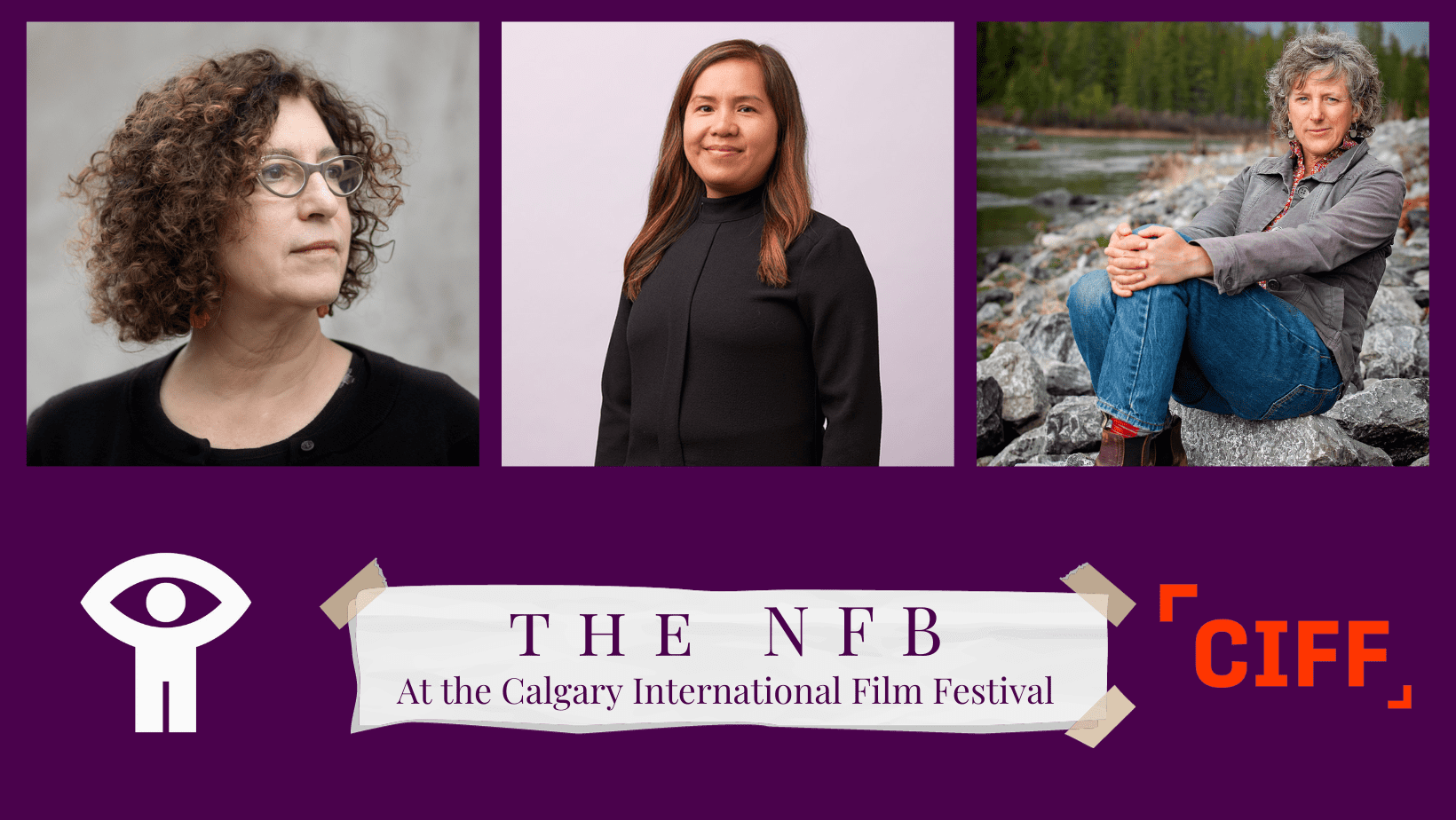Playing at the Calgary International Film Festival
I recently had the chance to interview the directors of three short films being screened at CIFF this year. These films were produced by the National Film Board of Canada, and I was deeply impressed by the diverse perspectives that the directors brought to the table.
From seasoned industry veterans with fifty years of experience to first-time directors, each of these women demonstrated a clear passion for filmmaking and a desire to share meaningful messages through their work.
Janet Perlman’s, “The Girl with the Red Beret”.
Video Courtesy of the National Film Board of Canada
A girl takes a wild ride on the metro in Montreal. Travelling from station to station, she encounters an array of colourful characters in a bizarre musical journey that’s peppered with hilarious and unexpected incidents.
Thao Lam and Kjell Boersma’s, “Boat People”:
Video Courtesy of the National Film Board of Canada
It comes down to karma: as a little girl in Vietnam, Thao’s mother would rescue ants from bowls of sugar water. The tiny creatures would later return the favour, leading her desperate family through darkness, and pointing the way to safety.
Leanne Allison’s, “Losing Blue”:

Poster Courtesy of the National Film Board of Canada
Blue is the colour of memory. The colour of glacier-fed alpine lakes comes from “deep time” processes and it is unlike anything else on Earth. This film explores Canada’s Rocky Mountain lakes as they are today, with the understanding that blue and its intangible power may someday be forgotten.
Janet Perlman on a Lengthy Career and Using Music as Inspiration
Adam Manery
You’re a bit of a legend in the Canadian animation scene. You’ve been animating professionally now for 50 years and many of your projects have received critical acclaim. You were even nominated for an Academy Award for your short film, “The Tender Tale of Cinderella Penguin”. How did you get started in this field and what keeps you going?
Janet Perlman
I wasn’t actually interested in animation to start with. I went to art school and I was given animation as a compulsory course. Can you believe that? I had courses in drawing, painting, and design, but I had very little interest in animation until I got an idea for something that got me fired up and excited. There were also teachers from the National Film Board of Canada at the school and their work was really inspiring. I saw all these films that I hadn’t seen before. There is such a wide array of films from the NFB, so I started to really enjoy the class and enjoy the process. I made my first film and it won a prize, which was a big deal at the time, of course. I was encouraged to keep going and then I got a job for the summer at the NFB. I stayed there for about seven years, making one film after another, and I really liked animation and drawing, and I still do!
I always have to have a project going, something happening, and I’m pretty fast, so I have a lot of them. I’ve done a lot of work over the years and I like all kinds of things. I think my favourite is a film like “The Girl with the Red Beret”, which is a short narrative film that I wrote and directed. That being said, I like animating other people’s films as well. I like other people’s styles, and I try to work in these different styles.
I’ve done commercials, but those are my least favourite things, actually. There’s a lot of stress involved, but in general, animation is not a very stressful field for me. I generally get things done in a reasonable amount of time without too much misery! I see that for some people in animation, the process seems to cause them grief and so much worry. I wonder why they go onto the next one. For me, though, it’s just a joy from beginning to end. I’m very happy to be doing it, and I’m going to keep going.
When it comes to your latest film, “The Girl with The Red Beret”, it revolves around the song “Complainte pour Ste. Catherine”. It’s essentially a Montreal Ballad made famous by Anna and Kate McGarrigle. How did this project come to be?
I’ve known the McGarrigle sisters since the time of that song, which was in the 70s. It was time for me to propose a new project to the NFB after I hit dead ends with a couple other proposals. All I had as an idea was to make a film to that song. The Film Board has done a few successful films with folk songs before. The wonderful thing about animated films is that they’re timeless. They live forever once they’re made. So I thought, they haven’t done a song for a while and I love this song, and honestly, that was about all. That was the whole idea, which is not a film idea at all. Still, I had to have something up my sleeve for when something I proposed got turned down, and when that happened, I was prepared. The producer, Marc Bertrand, who I’ve been working with for many years in the French animation studio at the NFB, thought it was interesting. I went off and thought, “what the heck did I just do?”.
I started to listen to the song some more and I realized that I never really listed to the lyrics in most songs, English or French. I just listen to the melody and the rhythm and that’s what attracts me to a song. So when I actually listened to the words, I only truly understood about half of them. It’s really a series of non sequitur lines. Just funny statements that don’t necessarily go together. There’s no exact theme, and it’s kind of a stream of consciousness, which is delightful. In fact, I found out the true story of it is that it was written in 20 minutes by Philippe Tatartcheff and they just needed a B-side for a record they were releasing. He just quickly went off into a room and pulled out this song.
There’s a bunch of random things in the song. “Saturday is hockey night, don’t say I’m not a Christian – I walk my dog every Sunday”. Just a little bit odd and satirical. It mentions 70s politics in Quebec, but then goes on to suggest it has been 20 years of war against mosquitoes, as if that’s the war they’re in. I picked up on different lines of the film and there’s reference to everything there, but I decided that the words aren’t the most important. I knew it was going to take place in the metro, but I didn’t know where it was going to go at all. It developed as I started going on the metro, sketching and taking secret photos, and it turns out there’s a whole lot of rich material there. If you go on the metro and look around, pretending you’re an animator, there’s plenty of stuff to pull from. “What’s with that hat”, “That person is beautiful”, “What’s that person carrying”, “That person is so rude”.
The story was developed over the course of a few months. It was based a little bit on when I was young and when I was around 12 I always wore a beret, and it turns out, so did Anna McGarrigle. That being said, the central character isn’t a drawing of me or anyone in particular. She just has qualities that hearken back to that time.
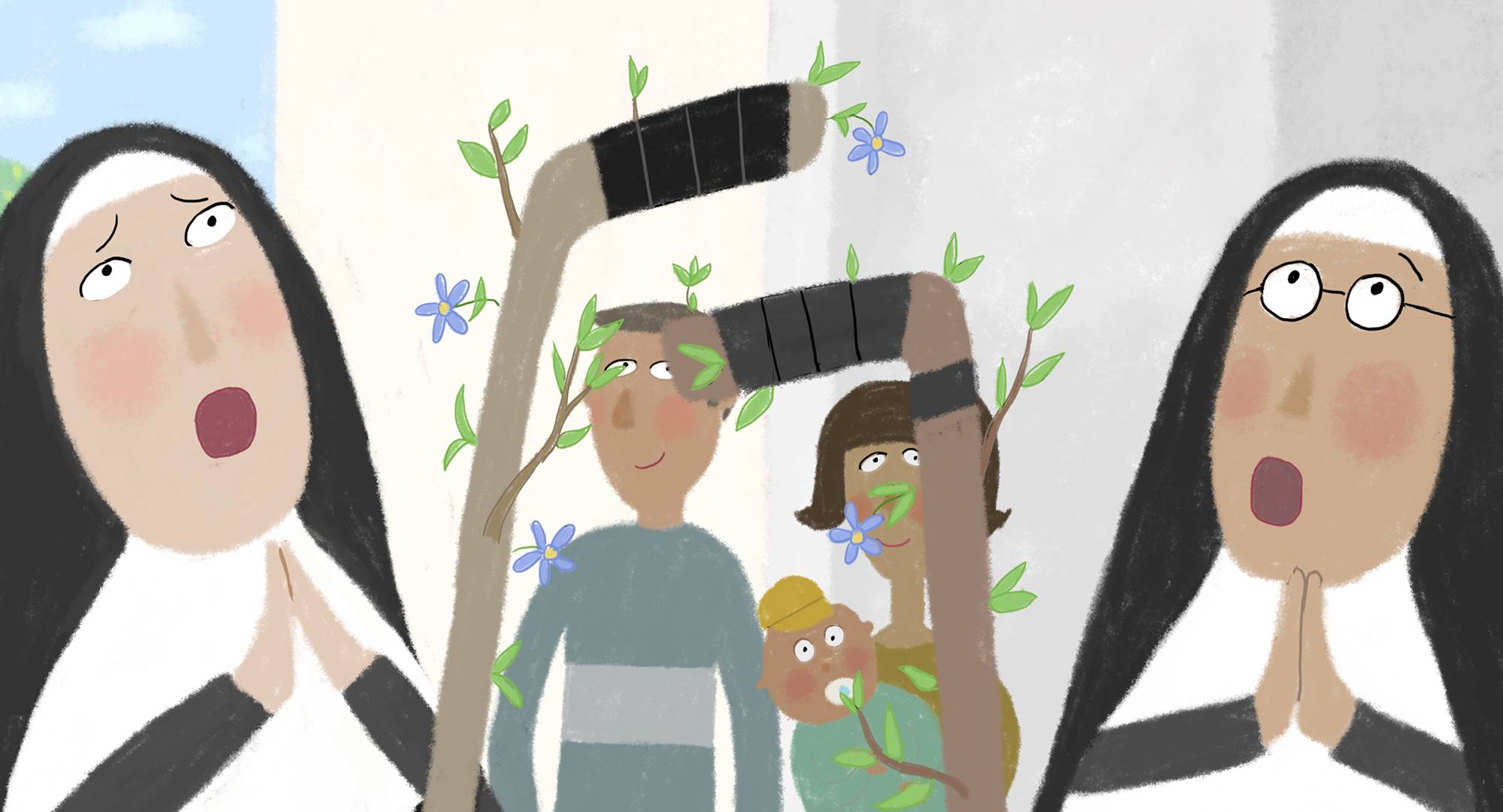
Kate McGarrigle unfortunately passed away in 2010, but Anna is still with us. What was her involvement like in this project?
I knew both Kate and Anna for a long time. I contacted Anna and asked her what she thought if I made an animated film of the song, and she was very happy about it. She came over for tea and I had to really quiz her about the lyrics because even if I understood most of it, I still had to ask what they meant about certain parts. She told me a little bit about how it came to be and after that I could see how the lyrics might have meaning to them, or might not have meaning at all, so I shouldn’t be so rigid or take it so seriously. I should just have fun. We wanted to have her involved as much as possible. She says she doesn’t really sing much anymore, and while I have heard her sing a bit, she doesn’t do it as much. Still, she was one of the nuns singing in this film, and she also played the accordion!
We wanted to recreate as much of the sound from the original song as possible and had to re-record the music. That was really scary for me, because I was worried that it would be difficult to do, as we didn’t have access to the original tracks or the original recording. The song was two and a half minutes long, and I made a five minute film, so there was a whole section in the middle with no music. Judith Gruber-Stitzer, who was responsible for musical adaptation and sound design, she was able to bring the music closer to the animation in a sense that sometimes she took the singing out and just had instrumentals that supported the animation. We were also able to get a few of the people who sang on the original to come and sing on the new version. They still work together, which is amazing. It’s really a close knit crowd of people, including the whole extended family.
On that note, the McGarrigles are part of an amazing part of Montreal music “lore”. Kate McGarrigle married the legendary Loudon Wainwright III, and they had two children, Rufus and Martha, who are both talented musicians. Not only that, but Rufus had a child with Lorca Cohen, Leonard Cohen’s daughter. It’s amazing how these two musical families came together in this way. In fact, Martha Wainwright even sang on this version of the song. What was it like having Anna and her niece Martha on this project together?
There’s actually a duet in the recording and both Lily Lanken and Martha Wainwright sing that part. Lily is Anna’s daughter, and Martha is Kate’s daughter, so it was so beautiful to have them recreate that part. Martha was great to have. She did an incredible job of getting the intonation that Anna had. There was nothing written down, Martha would just listen and say, “wait, I think I hear a high part in there” and then she would go and do it. It was really something.
The film’s visuals go so perfectly with the absurd nature of the lyrics at times, but our protagonist is just dancing through the chaos. She seems to almost be in a state of “blissful ignorance”. Was this an intentional point of focus?
I put together a scenario of what happens, which involves a thief and the police, and a clown and a woman with shopping bags. Given how all these different characters interact, it seemed like there needed to be another central character, and there wasn’t initially. Then, the idea developed that there would be this girl who takes a ride from one place to another and we would go along with her on this journey. She’s always there, but nothing happens to her directly, and she doesn’t notice anything around her. We’re watching a story unfold and she doesn’t notice anything, and I really thought that was funny. There seems to be this rule in film, though, that your central character needs to evolve and go through some sort of growth to come to a realization. But I decided that everything would happen around the character and it would never be explained why we’re always with her.
You just go with her. That’s it.
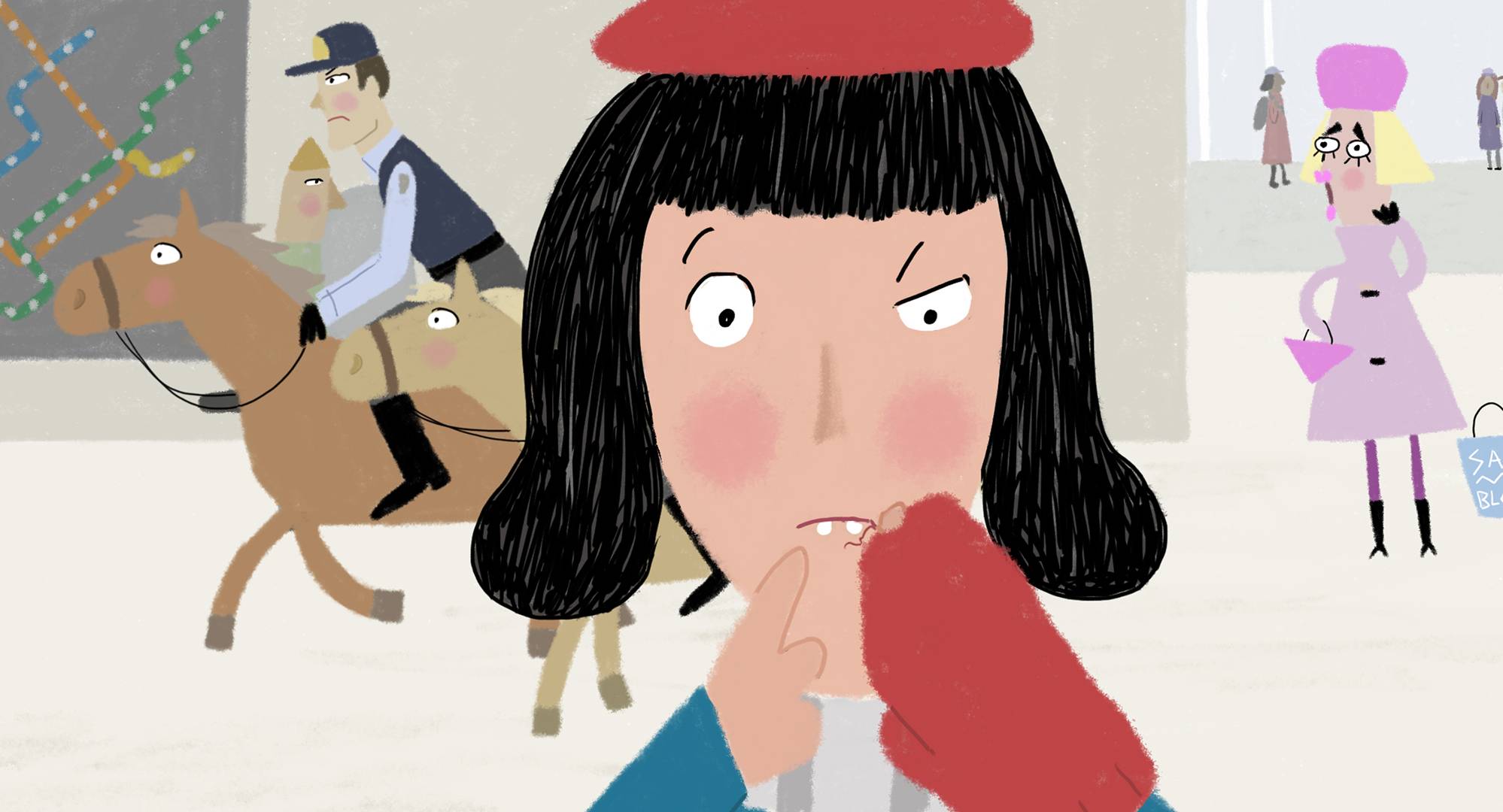
Thao Lam on Bringing Empathy and Compassion to the Screen
Adam Manery
This film was adapted from a book you wrote, called “The Paper Boat”. Was it always the plan to turn it into a film?
Thao Lam
Originally, when the idea came into my head, I wanted to do it as a film because having refugees escaping from a country is all about movement. The journey to the boat, then getting to Malaysia, and then getting to Canada. It’s all one large journey of movement. The ants in the film are also all about movement, so I wanted the story to move because I thought it played an important part in telling the story and giving the audience an idea of the hardships experienced and the overall extent of the journey. That way, it’s easier to understand what they have to go through to survive.
However, I discovered that getting a film grant was equally as hard, or even harder, than getting a grant to write a book, so it took a long time to find the right partner, who would be willing to take a chance on a newbie like me. Like any artist, I needed to make a living, so I had the chance to make a book with it first, and then we were very lucky to find a partnership with The National Film Board of Canada.
How has the filmmaking process compared to illustration?
It’s been overwhelming, partly because I’m new to the industry. I can tell a story, but it’s a very different format and medium and far more versatile. There’s so many things you need to pay attention to, like sound and lighting, and camera angles, and dialogue, whereas in a book there’s much less of that. With the filmmaking process, there’s so much I was unaware of. As a long-time movie lover, I didn’t pay attention to all those things. I don’t know what’s going on behind the kitchen – I’m just enjoying it.
It was really quite an eye opener for me and I was so lucky that the NFB had great resources and was very supportive and patient with me. There was always someone who was willing to give me a helping hand and it was also really great to have a partner in this. My co-director, Kjell Boersman, was supportive and would listen to me rant or complain about something because I didn’t understand it, or I was getting frustrated. It was a learning curve, but exciting at the same time because it was my first film, so I was able to approach it with excitement and naïveté at the same time, and I wasn’t jaded yet! My second film might be a different conversation, but this first one was like being a kid in a candy shop. I just thought to myself, “this is wonderful. I love it”.
The film is based on your family’s life experiences, as you came to Canada from Vietnam as a very young refugee. Is this a story you always wanted to share with the world?
It started off as I was doing research on how people start over. How do you leave everything and start again from nothing? I was going through a divorce at the time, and it felt like I was starting over with nothing. I envisioned my parents doing that. Starting over with a child, and my mother being pregnant at the time as well. How did people do that? So I started reading stories about other refugees and their struggles. Every time I read a different version of refugees from Syria, or Vietnam, or Cuba, everyone had the same traits. They were resilient and were willing to sacrifice for their family, not knowing what the end result would be.
It helps put in perspective what you’re dealing with and allows you to feel grateful. Yes, I was going through a divorce, but how does that compare to someone who was crossing the sea? Plus, reading about others struggles helps you feel good about humankind overall. You hear about people providing others with food and blankets in refugee camps, or churches and communities who were sponsoring families to come to Canada, pooling money together to help others. Just gathering together to rally around a cause. It was very enlightening and it made me feel like I could do this. This project gave me something to dive into and get lost in.
It’s the same way when I write children’s books. Each book gives me the opportunity to dive into a subject I’m not aware of or to learn something new. Every new project is like a therapy session, and that’s what “Boat People” was for me.
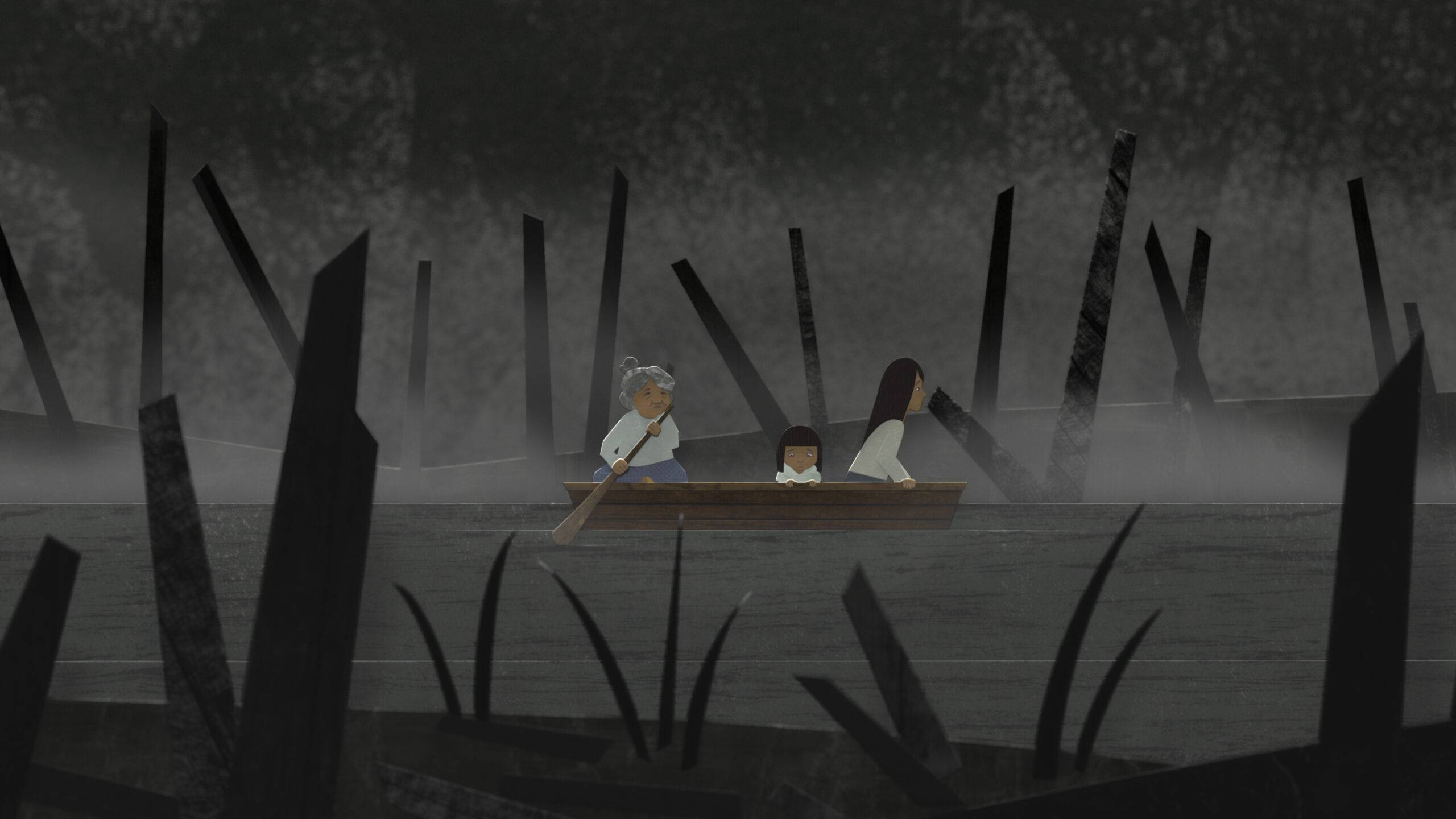
Throughout the film, you use a metaphor of ants and what they’re willing to do for their family. Was this idea always there in the writing process, or did it emerge somewhere along the way?
The story started off with my mother’s story. She always used the story of these ants guiding her from Vietnam to Canada. People want to know about the journey, almost like watching a car accident, but she’s never given the details. The only thing she ever tells is the story about the ants. Whether it’s true or not, it has become this family legend. I did some research on ants, mostly as a method of procrastination, and I read a lot about their personality, their physical form – anything I could get my hands on. The more I learned about them, the more fascinated I got. They don’t communicate, but somehow they get things done. The elderly will stay behind while the young ones head out front and look for food or lead the way somewhere. The elderly will stay behind because they’ve already lived their lives and they’re willing to sacrifice by staying behind and protecting the others.
That’s human nature at its most basic, isn’t it? Their animal instinct to protect their loved ones is so strong. We are instinctive in that same way. We want to protect our children. You hear stories in Vietnam, where people were handing over their babies to soldiers onto boats, just to give their children an opportunity to move on to a better life, while they stayed behind. Stories like that allow you to see these shared instincts with animals and humans. At the end of the day, we want to protect our children.
You serve as the narrator throughout “Boat People”. Is that something you knew you wanted to do?
I was the only one on the team that was holding out that George Clooney was going to play me. Honestly, I don’t like to hear the sound of my own voice, but everybody else thought it made total sense. I was the only one who didn’t know until the very end, but we had to record it. It was a wonderful experience to figure it out and learn something new, but it still feels weird to hear my voice coming out of a screen.
Obviously, your writing is beautiful. The animation was wonderful. But what really brought everything together and made this a true film was the sound design. What was that process like?
The sound was also something new to me. I was very lost, so I was thankful that Kjell was interested in music. He took the direction on that, and I was happy to follow his lead. You’re right, though, it’s very beautiful. It all came together, and we tried a number of different composers along the way. That was partly because I didn’t have the ability to picture how it works. They would ask what kind of music I hear when I think about the story, and I had no idea – my music taste is awful. To put in all this work and then having K-Pop play in the background isn’t quite right.
So, I’m glad there were people who stepped in and figured out how to make it work. We tried the classical route, and we even tried it without narration and no other sound outside of live sounds, like old footage in the field in Vietnam with sounds of helicopters. In the end, we found a great composer and a great sound mixer and somehow it all came together. The thing about film is that there’s so many different people playing a role and now I can’t watch a movie and not want to applaud every person on the team. That’s very different than book making. In book making, you have maybe five people on the team, so meeting all of these nice people was one of the greatest gifts I received from this movie.
What do you hope people take away after watching this film?
I just want people to understand each other a little better. There’s a lot of conversation in the news these past few years about refugees, and whether we should take them in. No one makes these decisions lightly, and I just want to say, “if you don’t have something nice to say, don’t say anything at all”. It seems like common sense. These people are escaping for their lives, they’re feeling like they’re in danger, and who wouldn’t want to be given an opportunity for a better life? These people are brave, they’re courageous. They’re willing to take a risk so they can give their children a better chance at a future. Being the reciprocate of that, I don’t take that for granted. I’m appreciative of the sacrifice and struggle that my parents went through to get me here. Without them, I wouldn’t be able to make a film. I have the luxury to write books – I have the freedom to do that.
A lot of us, myself included, who are living in a country that isn’t currently at war, or starving, or that climate change hasn’t drastically affected our crops, can sit here and Tweet or post something ignorant or insensitive. I just want everyone to walk away, take a breather, and say, “we can be nicer to each other”. Can’t we?
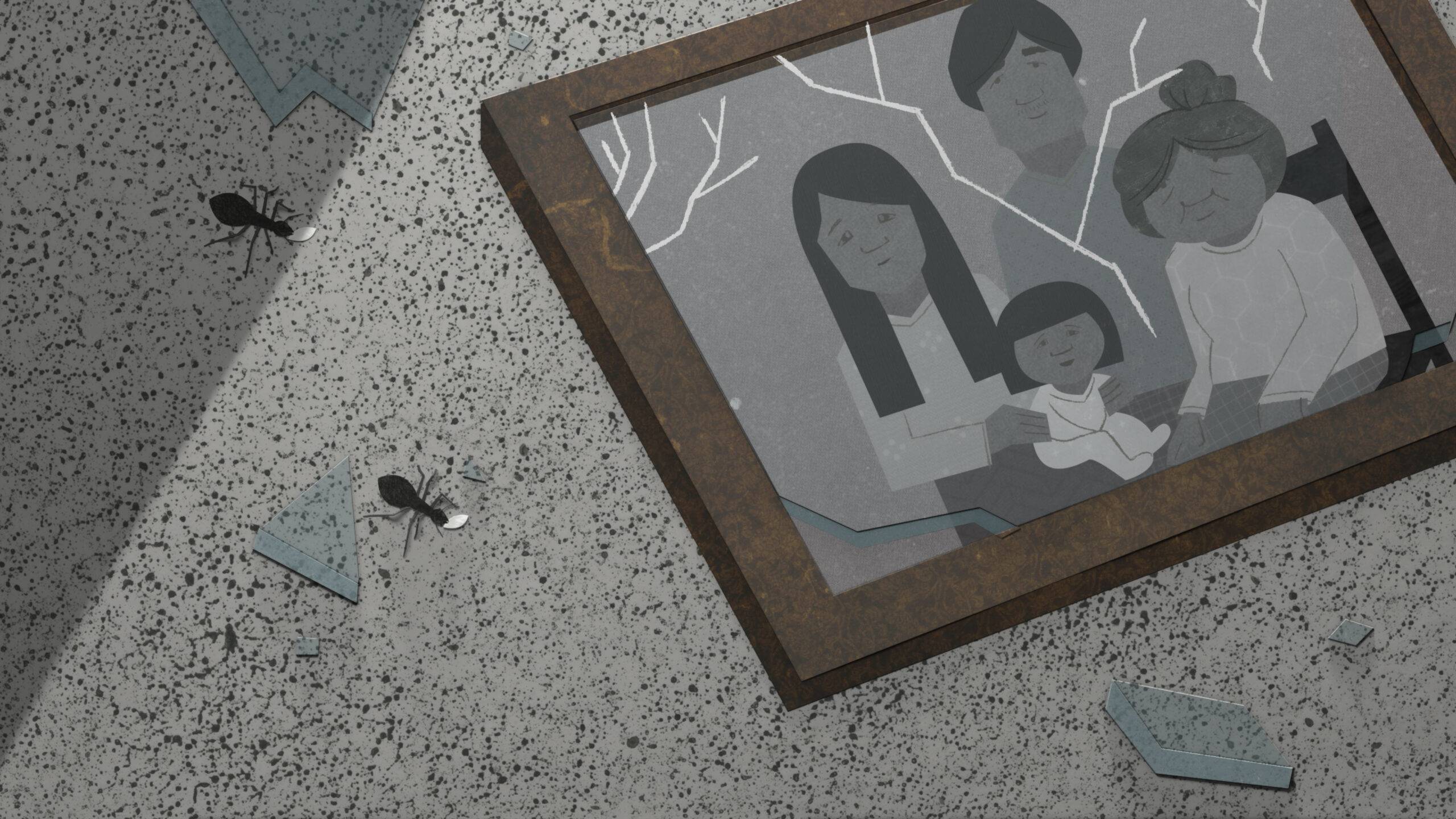
Leanne Allison on Using Nature as a Central Character
Adam Manery
You’ve made a number of films, like Being Caribou, and the interactive film Bear 71. The theme that unites your work is nature and the environment. When did your passion for environmentalism merge with filmmaking?
Leanne Allison
Being Caribou was my first film back in 2004. At that time, I was working with a conservation group on the coast, and we were putting out these short videos and getting amazing images of wolves and these remote coastal estuaries. We put out this scientific wolf, and we paired the wolf report with a bunch of imagery of the wolves. That night, on CBC The National, Peter Mansbridge was talking about our wolf research. At that point I realized that was how we would be able to get the stories out there. When my husband, Karsten Heuer, and I were going to head up and follow Caribou for five months on foot across the Arctic, I thought we should record all of it for B-roll for the news. It was only in my wildest dreams that I would actually be able to make a documentary. We went to the National Film Board ahead of time, but I had not track record, and I had never made a film. They said, “oh, you’re going to go follow Caribou for five months? Good luck with that”, and they gave us a little bit of money just to see.
I went to this little film school on the coast for one week. It was a crash course for documentary filmmaking, so I learned the basics. I called up a philanthropist who was working on the environmental issues that were related to why we were doing the trip. I said, “I’m a truck driver without a truck. I need to take a camera for this trip”. He asked how much I needed, and I told him that I only needed $10,000. That’s how I ended up getting all the gear. The journey itself was so incredible that we had an amazing story to tell. Ever since then, I’ve been interested in telling these environmental stories and doing it a bit differently.
With the interactive documentary, Bear 71, the NFB was interested in making new, interactive media. I saw the work of another US artist, and he had taken an image every five minutes during this whale hunt in Alaska, no matter what. It was a web-based project with thousands and thousands of images. I immediately thought about living here in Canmore, and how we often see the trailcam of animals. They’re so great because these animals are just living their lives. I thought this would be a great way to tell a story about that bear in the film, and it evolved from there. I spent a few months going through tons of images and realized that we knew the stories of some of these animals. They’re collared and are essentially being watched. We knew where they’d been last week on Wednesday, and this was a true story that we could tell.
I remember looking at these images that were captured of a grizzly bear coming down a railway track. I started to imagine what the bear might be thinking, and I gave it a voice. We realized just how powerful this could be. After that, we got J.B. MacKinnon involved as a writer. At the heart of it, it was a story told from the perspective of a grizzly bear trying to figure out how to live in this very busy place.
How did the idea for Losing Blue come about?
There is a husband and wife science team (Janet Fischer and Mark Olson) who studied the ecology of Rocky Mountain lakes. They teach down in the States at Franklin & Marshall College, but have been coming up here for 17 years studying the lakes. They found that while they were up here, people were always asking them about the colour of the lakes and the impact of climate change. One year, they applied for some extra money to make a video. They knew some of my work, so they came to me with the title of the film, and they had two stipulations. One, they didn’t want to be in the film. And two, they didn’t want it to be a conventional “show and tell” science video.
That was great, as it really opened things up. They weren’t in much of a hurry either, so I started tagging along with them on some of their field work and visiting these lakes. I learned some basic stuff that I didn’t know. All lakes are born through glacial retreat or volcanic activity, and all lakes eventually fill with sediment and disappear. They die. No two lakes are the same. Every single lake is unique, with its own unique fingerprint. Because of the other projects we had done with exploring some unique perspectives, I wondered if we could tell this story from the perspective of the lake losing its beauty. We talked about that idea and how we could approach it, but in the end, it was a bit too much.
Are there any takeaways you want folks to leave with after watching this film?
I just hope that people see Losing Blue and see things a little bit differently. We have this line in the film about how blue is the strangest colour in nature. Rare in the things we can hold, like birds, flowers, stones, and everywhere in things we can’t hold. Maybe the next time people are outside, they’ll look at the sky and think about that line. They’ll think about time. Hopefully people will be moved enough to just think about what it means to lose colour.
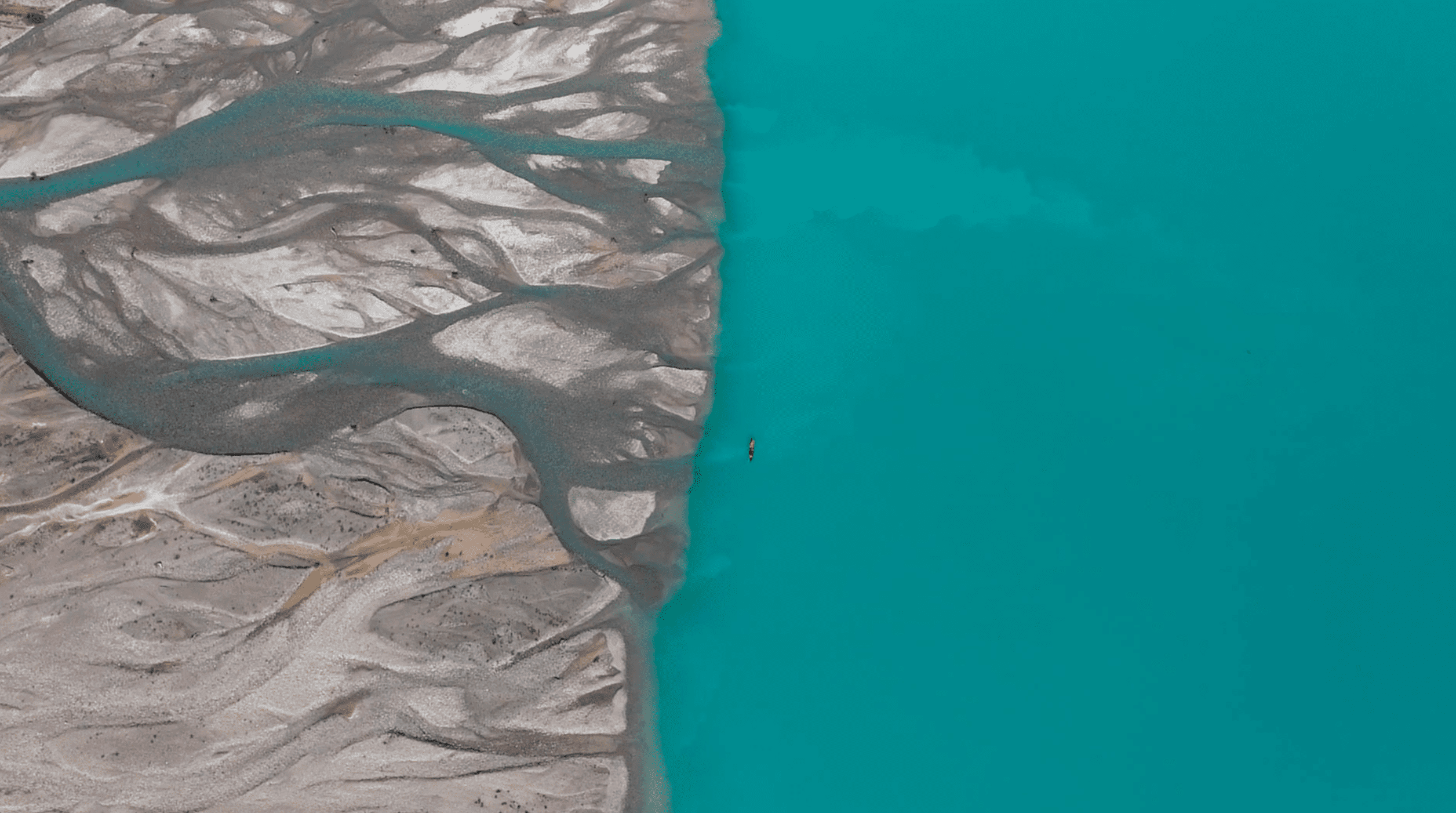
Image Courtesy of The National Film Board of Canada

